GE’s Grid Solutions business has announced a new milestone in its Champa-Kurukshetra ultra-high-voltage direct current (UHVDC) project in India with the 1,305-km link now capable of transmitting 4,500 MW of electricity.
This follows the recent successful energization of the third of four poles planned for the ±800kV UHVDC transmission line.
A special feature of the Champa project is the use of an overhead line with dedicated metallic return, which uses a neutral conductor as a part of the DC circuit. GE is the first company in the world to demonstrate this technology with this project and is therefore providing additional value to the customer by eliminating the typical technical and environmental issues associated with the traditional electrode solution.
The ±800kV UHVDC transmission line is a crucial component of the Indian government’s electricity-for-all initiative, providing reliable electricity for 46 per cent of its population. Upon completion, the 1,305-km link will have the capacity to transmit 6,000 MW of electricity at ±800kV, making it one of the largest generation-to-consumption transmission systems in the world
The transmission line is a crucial component of the Indian government’s electricity-for-all initiative and will help provide reliable electricity for millions of people living in the states of Punjab, Haryana, Delhi, Uttar Pradesh and surrounding areas. The project is being executed by GE T&D India Ltd, the listed entity of GE’s Grid Solutions business in India.
New government initiatives and robust private-sector investments have reversed India’s longstanding power deficit. With the growing renewable energy market, the nation now boasts an installed capacity of over 360 GW, making it the third-largest electricity producer in the world. However, to meet the government’s vision of power-to-all and to ensure last mile connectivity, continuous development of a robust transmission network is vital for the country.
Power Grid Corporation of India Ltd, India’s largest state-owned transmission company, is helping address this issue by connecting the power deficit northern Indian region with power surplus regions of eastern India using GE’s UHVDC technology.
“Thanks to this latest milestone in the GE Champa-Kurukshetra project, India is now transmitting more electricity over this link than any other DC link in India, helping to resolve the supply shortfalls in the north. This project also includes an integration where two separately designed bi-poles are running in parallel operation over the same DC transmission line, a design feature only seen on two other HVDC projects in the world, both of which GE was involved with, a great compliment to our legacy and current HVDC controls capability. On behalf of everyone at GE’s Grid Solutions, I would like to thank our teams in India and our UK HVDC center of excellence for this remarkable feat,” said Rajendra Iyer, head of Grid Integrated Solutions at GE’s Grid Solutions.
The Grid Integration Solutions division, comprised of HVDC and FACTS technologies, designs and integrates transmission solutions that help meet the world’s ever-evolving power needs.
With Pole-3 of the Champa-Kurukshetra UHVDC project complete, this DC link is now transmitting more electricity than any other DC link in India.
The project: The Champa-Kurukshetra project transmits electricity from power generating plants located across Chhattisgarh, to a GE-built rectifier station in Champa, where it is converted from AC to DC. The electricity is transported in bulk across the UHVDC line and is then converted back to AC by a GE inverter station in Kurukshetra, Haryana. From there, power is transported to the surrounding rural states that are in need of reliable and consistent electrical power. DC technology efficiently moves electricity over long distances which lowers transmission costs and losses. Additionally, it is a more environment-friendly technology because it requires fewer overhead lines to deliver the same amount of power as a high-voltage AC system.
Also Read: Phase-I of Champa-Kurukshetra UHVDC transmission system completed (October 2017)
Pole-1 and Pole-2: Phase 1 of the project, completed in 2017, provided 3,000 MW of transmission capacity. GE’s recent energization of Pole-3 added another 1,500 MW of transmission capacity, marking a key benchmark towards the completion of Phase 2. Once Pole 4 is commissioned, the entire system will transmit 6,000 MW of electricity at 800kV that can make the project one of the largest generation-to-consumption transmission systems in the world.
Featured photograph gives an inside view of the valve hall of the Champa-Kurukshetra HDVC converter station.

